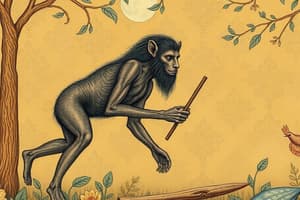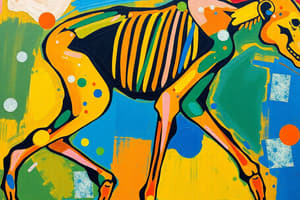Podcast
Questions and Answers
What concept did Charles Darwin introduce to explain the origins of modern humans?
What concept did Charles Darwin introduce to explain the origins of modern humans?
- Natural Selection (correct)
- Mutation Theory
- Survival of the fittest
- Genetic Drift
Which statement best describes Natural Selection?
Which statement best describes Natural Selection?
- It increases the frequency of traits that enhance survival and reproductive success. (correct)
- It requires environmental changes to occur.
- It leads to decreased survival rates in populations.
- It results in the random changes of all traits over generations.
What does the term 'bipedalism' refer to?
What does the term 'bipedalism' refer to?
- The ability to run on all fours.
- Walking on two feet in an upright position. (correct)
- Changing physical form drastically.
- The process of adaptation to new environments.
According to Darwin, how are species related?
According to Darwin, how are species related?
What is meant by 'changes in genetics and inherited traits'?
What is meant by 'changes in genetics and inherited traits'?
What is a distinguishing feature of Homo Erectus?
What is a distinguishing feature of Homo Erectus?
Which characteristic best describes Homo Sapiens?
Which characteristic best describes Homo Sapiens?
What does sociopolitical evolution primarily involve?
What does sociopolitical evolution primarily involve?
Which of the following societies develops after the hunting and gathering phase?
Which of the following societies develops after the hunting and gathering phase?
What significant change is not associated with Homo Sapiens?
What significant change is not associated with Homo Sapiens?
What is the brain size of Sahelanthropus tchadensis?
What is the brain size of Sahelanthropus tchadensis?
Which species is known for using Oldowan tools?
Which species is known for using Oldowan tools?
What distinguishes Australopithecus robustus from Australopithecus gracilis?
What distinguishes Australopithecus robustus from Australopithecus gracilis?
How far could Australopithecus move to search for food?
How far could Australopithecus move to search for food?
What was the primary habitat of Ardipithecus?
What was the primary habitat of Ardipithecus?
Which characteristic is true for Homo ergaster?
Which characteristic is true for Homo ergaster?
What is the estimated height of Australopithecus?
What is the estimated height of Australopithecus?
What significant feature is attributed to Homo habilis?
What significant feature is attributed to Homo habilis?
Flashcards are hidden until you start studying
Study Notes
Biological Evolution
- Physical Transformation: Changes and variations in the genetics and inherited traits of biological populations over generations.
- Charles Darwin: English naturalist and geologist who proposed evolution as an explanation for the origins of modern humans.
- Natural Selection: Process affecting the frequency of traits within an environment; traits that enhance survival and reproduction become more common.
Hominin Evolution
- Sahelanthropus tchadensis (6-7 million years ago): Ape-like and human-like features, similar height to chimpanzees, small brain, walked upright.
- Ardipithecus (4-5 million years ago): Ape-like skull, small brain, walked upright, lived in jungles and forests.
- Australopithecus (5-1 million years ago):
- Gracile australopithecines: Small teeth and jaws, examples include Australopithecus anamensis, afarensis, and africanus.
- Robust australopithecines: Large teeth and jaws, muscular build, examples include Australopithecus aethiopicus, robustus, and boisei.
- Lucy (3.2 million years old): Australopithecus afarensis fossil, significant early human ancestor.
- Homo Habilis ("Handy Man"): Direct ancestor of modern humans, known for toolmaking abilities.
- Height: 3-4 feet
- Brain: Half the size of a modern human brain
- Oldowan tools: Used for cutting and made from volcanic stones.
- Homo Ergaster ("Homo Erectus came from"): Existed 1.8 million years ago, a predecessor to Homo Erectus.
- Homo Erectus ("Upright Man & Skillful Hunters"): Lived from 1.8 million to 300,000 years ago, more intelligent and adaptable than Homo Habilis.
- Brain: About 2/3 the size of a modern human brain
- Height: About 5 feet
- Tools: Complex tools for digging, cutting, scraping, and hand axes for slicing, chopping, and digging.
- Homo Sapiens ("Wise Man & Modern Humans"): Sophisticated tools, advanced shelters, and technology.
- Brain: Almost the size of a modern human brain
- Activities: Used fire, crafted metals, gathered and cooked shellfish, hunted, and gathered food.
Cultural Evolution
- Human adaptation: Humans modify their culture over time in response to environmental threats and challenges.
- Sociopolitical Evolution: Transformation of societies and political systems due to cultural evolution: development of new economic systems, knowledge acquisition, and technology application.
- Gerhard Lenski (1924-2015): American sociologist who argued for a process of social evolution driven by technological advancement.
Societies
- Hunting & Gathering Societies: Early human societies reliant on hunting and foraging for food.
- Horticultural & Pastoral Societies: Societies that cultivate plants or raise livestock for food, leading to more settled lifestyles and population growth.
- Agricultural Societies (Neolithic): Societies characterized by advanced agriculture, including irrigation and plows, leading to further population growth, specialization, and complex social structures.
- Industrial Societies: Societies that rely on mechanical and technological production for economic growth and increasing specialization.
- Post-Industrial Societies: Societies characterized by information technology, knowledge-based industries, and a focus on services rather than manufacturing.
Political Evolution
- Transformation of political systems: Political structures evolve in response to cultural and technological developments.
Studying That Suits You
Use AI to generate personalized quizzes and flashcards to suit your learning preferences.




